
Ceragenin
Encyclopedia
Ceragenins, or cationic steroid antibiotics (CSAs), are synthetically produced small molecule chemical compounds consisting of a sterol
backbone with amino acids and other chemical groups attached to them. These compounds have a net positive charge that is electrostatically attracted to the negatively charged cell membranes of certain viruses, fungi and bacteria. CSAs have a high binding affinity for such membranes (including Lipid A
) and are able to rapidly disrupt the target membranes leading to rapid cell death. While CSAs have a mechanism of action that is also seen in antimicrobial peptides, which form part of the body's innate immune system, they avoid many of the difficulties associated with their use as medicines.
 Ceragenins were invented by Dr. Paul B. Savage of Brigham Young University
Ceragenins were invented by Dr. Paul B. Savage of Brigham Young University
's Department of Chemistry and Biochemistry and exclusively licensed to Ceragenix. In data previously presented by Dr. Savage and other researchers, CSAs have been shown to have broad spectrum antibacterial activity. Dr. Derya Unutmaz, Associate Professor of Microbiology and Immunology at the Vanderbilt University School of Medicine, tested several CSAs in his laboratory for their ability to kill HIV
directly. According to Unutmaz, "We have some preliminary but very exciting results. But we would like to formally show this before making any claims that would cause unwanted hype."
On February 6, 2006, researchers (including Dr. Paul B. Savage) announced that a Ceragenin compound, CSA-54, appears to inactivate HIV. This conclusion seems to still be awaiting peer review.
Sterol
Sterols, also known as steroid alcohols, are a subgroup of the steroids and an important class of organic molecules. They occur naturally in plants, animals, and fungi, with the most familiar type of animal sterol being cholesterol...
backbone with amino acids and other chemical groups attached to them. These compounds have a net positive charge that is electrostatically attracted to the negatively charged cell membranes of certain viruses, fungi and bacteria. CSAs have a high binding affinity for such membranes (including Lipid A
Lipid A
Lipid A is a lipid component of an endotoxin held responsible for toxicity of Gram-negative bacteria. It is the innermost of the three regions of the lipopolysaccharide molecule, and its hydrophobic nature allows it to anchor the LPS to the outer membrane...
) and are able to rapidly disrupt the target membranes leading to rapid cell death. While CSAs have a mechanism of action that is also seen in antimicrobial peptides, which form part of the body's innate immune system, they avoid many of the difficulties associated with their use as medicines.

Brigham Young University
Brigham Young University is a private university located in Provo, Utah. It is owned and operated by The Church of Jesus Christ of Latter-day Saints , and is the United States' largest religious university and third-largest private university.Approximately 98% of the university's 34,000 students...
's Department of Chemistry and Biochemistry and exclusively licensed to Ceragenix. In data previously presented by Dr. Savage and other researchers, CSAs have been shown to have broad spectrum antibacterial activity. Dr. Derya Unutmaz, Associate Professor of Microbiology and Immunology at the Vanderbilt University School of Medicine, tested several CSAs in his laboratory for their ability to kill HIV
HIV
Human immunodeficiency virus is a lentivirus that causes acquired immunodeficiency syndrome , a condition in humans in which progressive failure of the immune system allows life-threatening opportunistic infections and cancers to thrive...
directly. According to Unutmaz, "We have some preliminary but very exciting results. But we would like to formally show this before making any claims that would cause unwanted hype."
On February 6, 2006, researchers (including Dr. Paul B. Savage) announced that a Ceragenin compound, CSA-54, appears to inactivate HIV. This conclusion seems to still be awaiting peer review.

